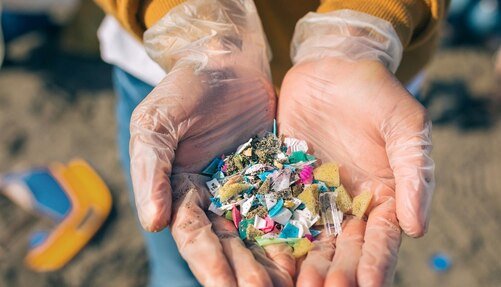Few human-made compounds are as ubiquitous and dangerous as poly-fluoroalkyl substances (PFAS), and microplastics are known to exist. According to ground-breaking research, these two contaminants show synergistic toxicity when combined, increasing the already significant health hazards they create to wildlife—including humans.
Within the experiment, what was tested?
Water fleas were subjected to a mix of PFAS and microplastics in an experiment run by UK university researchers. The findings were startling: the species had notably lower birth rates and developmental impairments, including stunted growth.
“The combination of PFAS and microplastics produced far worse outcomes than when these substances were tested individually,” the researchers said. “This result emphasizes the need for a more thorough investigation on the consequences of chemical mixtures as opposed to studying these substances alone.”
What are Microplastics and PFAS?

About 15,000 artificial compounds known as PFAS are infamous for their environmental persistence. Often called “forever chemicals,” they build over time and resist natural breakdown. Commonly employed to make water- and stain-resistant items, these chemicals significantly affect health, ranging from cancer and kidney illness to immune system malfunction and birth problems.
Conversely, microplastics are tiny bits of plastic derived from direct manufacturing for use in products or the breakdown of more substantial plastic objects. These microplastics have been discovered in human bodies and many ecosystems, even breaching the blood-brain barrier. Research has linked microplastics to developmental problems, hormonal disturbance, heart illnesses, and other health difficulties.
What Risk Do PFAS and Microplastics Share?
The fact that plastics are sometimes treated with PFAS makes this mix especially alarming, as microplastics usually contain these dangerous compounds. When both toxins are present in the environment combined, this combination could produce even more hazardous results.
Researchers subjected two sets of water fleas to a dangerous concoction. Whereas one group had never been exposed to pollution, the other had past knowledge of chemical toxins. Because of their extraordinary sensitivity to chemicals, which makes them a perfect model for comprehending the consequences of contaminants, water fleas are often utilized in ecological toxicity research.
Both groups were fed a mixture of two of the most harmful PFAS chemicals, PFOA (perfluorooctanoic acid) and PFOS (perfluorooctane sulfonate), together with microplastics—more significantly, PET (polyethylene terephthalate). This combo was meant to replicate the pollution levels seen in lakes worldwide.
What Experiment Results Were Found?
The study revealed that the combination of microplastics and PFAS was considerably more harmful than either chemical taken alone. The researchers believe the synergy between the compounds, which raised their adverse effects, could be responsible for around forty percent of the higher toxicity. The interaction between the charges on the microplastics and the PFAS molecules most certainly generates this synergy.
The researchers clarified that the combined toxicity of PFAS and microplastics was far higher than that of any one chemical in isolation. “This synergy seems to increase the general damage, hence the mixture becomes even more hazardous.”
The simple additive effects of both compounds were blamed for the remaining 60% of the toxicity rise.
What Impact Did the Toxic Mixture Create on Wildlife?
The water fleas subjected to the poisonous concoction displayed significant health issues. They generated fewer offspring, and those that survived were smaller and showed delayed sexual development. These results especially worry wildlife populations depending on the timely development and reproduction of aquatic life.
“Fleas exposed to the mixture of PFAS and microplastics showed a distinctly lower number of offspring,” the researchers observed. “They were also smaller at maturities and displayed delayed sexual development, which could have long-term effects on populations exposed to comparable pollution.”
How Might Human and Environmental Health Be Affected? The findings of this research cause serious questions regarding not only aquatic environments but also human health. Given their ubiquitous presence in the environment and regular coexistence, PFAS and microplastics should be considered together in policies and environmental preservation projects.
The writers stressed the need for ongoing research on the harmful effects of these compounds on wildlife to guide policies and conservation initiatives. “We cannot afford to discount the likelihood of synergistic effects when both of these contaminants are present in the environment.”
Why is a thorough investigation of chemical mixtures so important?
This research emphasizes the need to realize the combined consequences of microplastics and chemical combinations, including PFAS. The combined toxicity of these contaminants could have terrible effects on human health and wildlife as they keep spreading throughout the surroundings.
Given the general awareness of PFAS and microplastics, experts underline the immediate need for a more extensive investigation into their combined impacts. Then, educated legislative regulations can be implemented to reduce the hazards that these harmful and recurring contaminants create.

